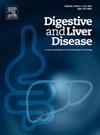具有再生潜力的人体大小的胆总管原型:力学、功能、降解和免疫调节的体外评估
IF 3.8
3区 医学
Q1 GASTROENTEROLOGY & HEPATOLOGY
引用次数: 0
摘要
组织工程为胆道缺损的治疗提供了新的希望。已经提出了几种支架,但它们的性质尚未得到充分研究。在本研究中,设计、制造和表征了一种新型的胆总管(CBD)样原型。该原型结合了两种生物相容性生物材料,甲基丙烯酸化I型胶原(CollMA)和聚ε-己内酯(PCL),以及胆道上皮细胞。组织学、功能和蛋白质组学分析显示,CollMA支持胆道上皮细胞组织成功能性胆道样上皮,而PCL提供机械强度。生物和机械阶段的原型是集成到一个多相管状支架使用成型和静电纺丝技术。最终的cbd样原型由三个互穿阶段组成:从最内层到最外层,分别是胆道上皮细胞负载的CollMA、PCL和CollMA。这种设计克服了多层结构的挑战,如层间分层和缺乏同质性。该原型在生理条件下保持稳定,使胆汁流动不泄漏,并表现出胆汁酸转运和修饰活性,为未来的体内临床前评估提供了依据。在离体人血液实验中,脱细胞原型引发了良好的免疫反应,限制了炎症并促进表皮生长因子(EGF)的持续释放,表明其支持再生过程的潜力。本文章由计算机程序翻译,如有差异,请以英文原文为准。
Engineering a Human-Sized Common Bile Duct Prototype with Regenerative Potential: In Vitro Evaluation of Mechanics, Function, Degradation, and Immune Modulation
Tissue engineering offers new hope for treating biliary defects. Several scaffolds have been proposed, but their properties have not been fully investigated. In this study, the design, fabrication, and characterization of a novel common bile duct (CBD)-like prototype are described. This prototype combines two biocompatible biomaterials, methacrylated type I collagen (CollMA) and poly(ε-caprolactone) (PCL), along with biliary epithelial cells. CollMA supports the organization of biliary epithelial cells into a functional biliary-like epithelium, as shown by histological, functional, and proteomic assays, while PCL provides mechanical strength. The biological and mechanical phases of the prototype are integrated into a multiphasic tubular scaffold using molding and electrospinning techniques. The final CBD-like prototype consists of three interpenetrating phases: from innermost to outermost, these are biliary epithelial cell-laden CollMA, PCL, and CollMA. This design overcomes challenges seen in multilayer constructs, such as interlayer delamination and lack of homogeneity. The prototype remains stable under physiological conditions, enables bile flow without leakage, and exhibits bile acid transport and modification activities, warranting future in vivo preclinical evaluation. In an ex vivo human blood assay, the acellular prototype elicited a favorable immune response, limiting inflammation and promoting sustained release of epidermal growth factor (EGF), indicating its potential to support regenerative processes.
求助全文
通过发布文献求助,成功后即可免费获取论文全文。
去求助
来源期刊

Digestive and Liver Disease
医学-胃肠肝病学
CiteScore
6.10
自引率
2.20%
发文量
632
审稿时长
19 days
期刊介绍:
Digestive and Liver Disease is an international journal of Gastroenterology and Hepatology. It is the official journal of Italian Association for the Study of the Liver (AISF); Italian Association for the Study of the Pancreas (AISP); Italian Association for Digestive Endoscopy (SIED); Italian Association for Hospital Gastroenterologists and Digestive Endoscopists (AIGO); Italian Society of Gastroenterology (SIGE); Italian Society of Pediatric Gastroenterology and Hepatology (SIGENP) and Italian Group for the Study of Inflammatory Bowel Disease (IG-IBD).
Digestive and Liver Disease publishes papers on basic and clinical research in the field of gastroenterology and hepatology.
Contributions consist of:
Original Papers
Correspondence to the Editor
Editorials, Reviews and Special Articles
Progress Reports
Image of the Month
Congress Proceedings
Symposia and Mini-symposia.
 求助内容:
求助内容: 应助结果提醒方式:
应助结果提醒方式:


